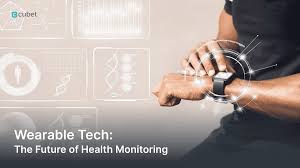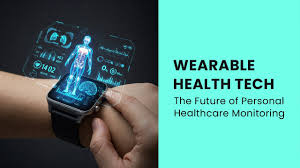
A decade ago, wearable devices were mostly glorified step counters—simple fitness trackers that encouraged us to move more. Fast forward to 2025, and wearable health tech has evolved into something far more powerful and personal. Today’s wearables aren’t just monitoring steps—they’re tracking your heart, your sleep, your stress, your glucose levels, and even your emotions.
In this new era, wearable technology is becoming a 24/7 health companion—one that could predict a heart attack before it happens, detect early signs of depression, or alert you to a sleep disorder you didn’t know you had. But with all this potential also comes important questions: How accurate is the data? Who gets access to it? And how far is too far?
Let’s explore how wearable health tech is changing lives—and what’s coming next.
1. Beyond Fitness: Into the Medical Mainstream
The biggest shift in 2025 is that wearables are no longer just fitness tools—they’re now recognized as legitimate medical devices. Regulators in the U.S., Europe, and Asia are increasingly approving wearables for clinical use, enabling doctors to use data from consumer devices to support diagnoses and treatment.
Modern wearables can now:
- Monitor heart rhythm and detect arrhythmias like atrial fibrillation
- Track blood oxygen (SpO₂) and respiratory rate
- Measure skin temperature for illness detection
- Detect falls or sudden health emergencies and alert emergency services
- Monitor chronic conditions like diabetes, hypertension, and sleep apnea
These capabilities are bringing healthcare out of the clinic and into people’s homes—turning passive patients into active participants in their own wellness.
2. Stress, Mood, and Mental Health Monitoring
It’s not just your body that wearables are watching—it’s your mind, too.
In 2025, a growing number of devices are focused on mental well-being:
- Cortisol sensors and heart rate variability (HRV) can indicate rising stress
- AI models analyze sleep patterns and voice tone to detect signs of anxiety or depression
- Smart rings, bands, and patches now offer guided breathing, mindfulness prompts, and even real-time mood tracking
This trend is opening up new ways to support mental health, particularly in early detection and intervention. But it also raises concerns about privacy and the emotional impact of being constantly “analyzed.”
3. Personalized Medicine Powered by Wearables
One-size-fits-all medicine is becoming a thing of the past. Wearable data enables hyper-personalized health care—where treatment plans are tailored to an individual’s real-time metrics, habits, and genetic risks.
Imagine:
- A smartwatch alerting your doctor to abnormal blood pressure patterns
- A glucose monitor adjusting your meal recommendations in real time
- A smart bra that tracks breast tissue changes and flags early signs of abnormalities
This kind of precision care is already saving lives and reducing costs. And as wearables sync with health apps, telemedicine platforms, and AI diagnostics, the healthcare experience becomes more responsive and preventative than ever before.
4. Fashion Meets Function: A Discreet Revolution
Gone are the bulky fitness bands and rigid heart monitors. In 2025, wearable health tech has become sleek, stylish, and seamless.
Popular formats include:
- Smart rings (e.g., Oura) that track sleep, activity, and recovery
- Skin patches that monitor glucose or deliver medication
- Smart clothing with embedded sensors to track posture, muscle tension, or hydration
- Earrings and necklaces that monitor temperature or heart rate discreetly
Design matters more than ever, as wearables blend into daily life and even become fashion statements—proof that tech and lifestyle no longer need to be at odds.
5. Real-Time Alerts, Real-Life Impact
One of the most life-changing benefits of wearable tech is its ability to alert users to health dangers in real time.
Examples from 2025 include:
- Smartwatches detecting heart irregularities and prompting users to seek urgent care—preventing strokes and heart attacks
- Sleep monitors identifying breathing issues and helping diagnose sleep apnea
- Smart rings detecting temperature spikes or oxygen drops before symptoms of flu or COVID appear
In emergencies, wearables can even share your health data with doctors, EMTs, or loved ones—automatically and instantly. It’s a lifeline that’s always with you.
6. The Privacy Trade-Off: Who Owns Your Health Data?
As wearables collect more intimate data, a major concern arises: privacy.
- Who owns the data—you or the company that makes the device?
- Is your health data being sold to insurers or advertisers?
- Could it be used to deny you coverage or employment?
These are not hypothetical questions. In 2025, several countries are grappling with the legal and ethical implications of constant biometric tracking. Some are pushing for digital health rights and stronger data protection laws to ensure that wearable data isn’t misused.
7. The Next Frontier: Implantables and Invisible Tech
What comes after wearables? Some say it’s “invisibles”—tiny, implantable or ultra-discreet sensors that offer continuous monitoring without any effort from the user.
Coming innovations include:
- Smart contact lenses that track blood sugar or detect eye diseases
- Under-the-skin implants for real-time biometrics
- Bio-integrated sensors that power themselves using body heat or motion
While these may sound futuristic, pilot programs are already underway—and they hint at a future where health monitoring could be as invisible as it is powerful.
Final Thoughts
Wearable health tech in 2025 is doing far more than counting steps—it’s transforming healthcare into something smarter, faster, and more personalized. Whether it’s detecting illness, improving sleep, managing stress, or predicting emergencies, these devices are redefining what it means to take control of your health.
But with that power comes responsibility: for users to understand their devices, for companies to protect their data, and for societies to ensure that innovation doesn’t outpace ethics.
